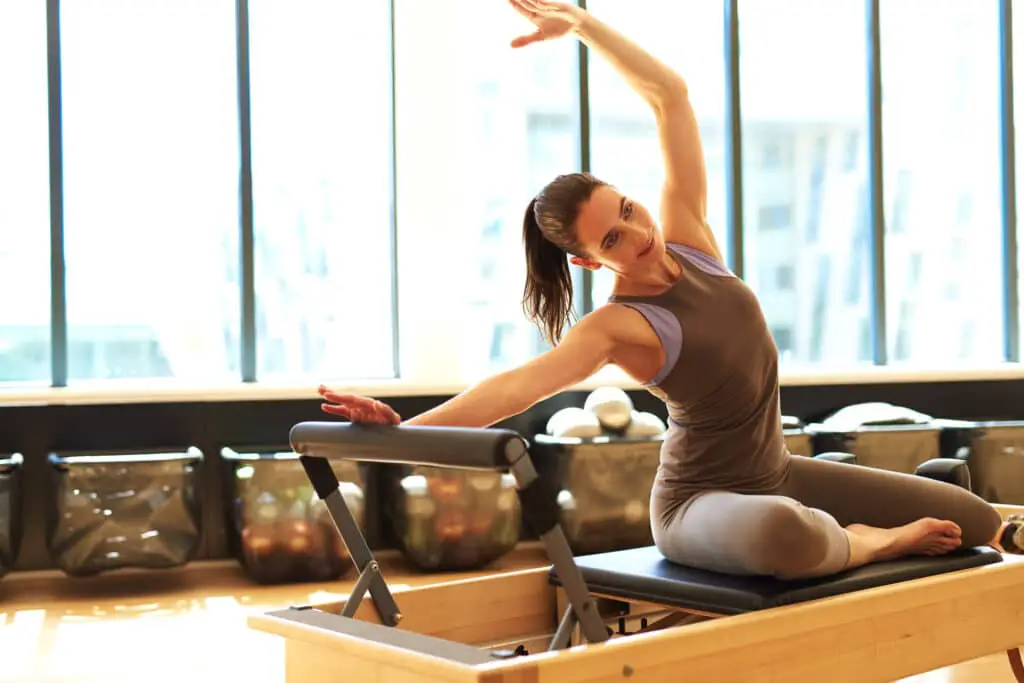Introduction
What Was Pilates Originally Called: Pilates, the popular fitness method known for its emphasis on core strength, flexibility, and overall body conditioning, originally bore a different name. In its inception, it was referred to as “Contrology” by its creator, Joseph Pilates. Born in Germany in 1883, Joseph Pilates developed this unique system of exercises in the early 20th century as a means to rehabilitate and strengthen the bodies of World War I soldiers.
Over time, Contrology, now widely recognized as Pilates, has evolved into a comprehensive fitness practice embraced by individuals seeking improved physical fitness, posture, and pilates ball mental well-being. This transformation from Contrology to Pilates reflects not only the evolution of the method itself but also its enduring impact on the world of fitness and holistic health. Today, Pilates studios and classes can be found worldwide, catering to people of all ages and fitness levels.
Joseph Pilates, the visionary behind the method, initially conceived Contrology as a holistic approach to health and well-being, believing that physical and mental fitness were interconnected. He developed a series of exercises that focused on controlled movements, precise breathing techniques, and the engagement of the body’s core muscles to create a harmonious union of mind and body. Its enduring popularity is a testament to the effectiveness of the exercises and their ability to promote physical strength, flexibility, and overall well-being.

What was Pilates first known as?
Pilates called his technique ‘Controlology’ – only later did it become known by his own surname. He conceived it as a mental as well as a physical conditioning in which individuals could work their bodies to their full potential.
Control: Central to Contrology is the concept of control, extending to every facet of the exercises. Joseph Pilates advocated for controlled and precise movements as essential for optimal physical development. He emphasized the need for practitioners to master their bodies, guiding each movement with intention and precision.
Ology: The suffix “ology” implies a systematic study or science. By incorporating this suffix into “control,” Joseph Pilates underscored that his method was not merely a series of exercises but a comprehensive and disciplined approach to physical and mental well-being. It was intended to be a science of control over the body.
Today, Pilates is recognized as a mainstream fitness practice with a global following. The name change from Contrology to Pilates has not altered the fundamental principles of the method. It still emphasizes control, precision, breath, and the integration of mind and body.
Pilates offers numerous benefits, including improved core strength, flexibility, posture, balance, and mental focus. It has proven to be a versatile and effective fitness practice for individuals of all ages and fitness levels. Additionally, Pilates is often used as a rehabilitation tool, aiding those recovering from injuries or seeking relief from chronic pain.
What is another name for Pilates?
Classical Pilates is known by several other names, including Traditional Pilates, Authentic Pilates, Roman Pilates, and Real Pilates.
Today, Pilates is recognized as a mainstream fitness practice with a global following. The name change from Contrology to Pilates has not altered the fundamental principles of the method. It still emphasizes control, precision, breath, and the integration of mind and body.
Pilates has proven its versatility and effectiveness for people of all ages and fitness levels. It offers numerous benefits, including improved core strength, flexibility, posture, balance, and mental focus. Pilates is often used not only for fitness but also as a rehabilitation tool, particularly for those recovering from injuries or seeking relief from chronic pain.
While Joseph Pilates coined the term Contrology and used it throughout his lifetime to describe his fitness method, it wasn’t until after his death in 1967 that the name began to transition to “Pilates.” This shift in nomenclature was largely driven by the increasing popularity of the method and the spread of Pilates studios and classes worldwide.
The suffix “ology” implies a systematic study or science. By adding this to “control,” Joseph Pilates emphasized that his method was not just a series of exercises but a comprehensive and disciplined approach to physical and mental well-being. It was meant to be a science of control over the body.
What did Joseph Pilates originally call Pilates?
During his lifetime this method of exercise was called Contrology. It was only after his death that it became known as the Pilates Method. While Joe is the man behind the method, it was his wife Clara that became the real teacher in the studio and allowed the method to be passed on to apprentices.
Pilates was originally called “Contrology” by its creator, Joseph Pilates, for a multitude of reasons deeply intertwined with his philosophy and approach to physical fitness and well-being. Understanding why Pilates was called Contrology provides insight into the fundamental principles and unique aspects of this exercise system.
Control, both mental and physical, was at the heart of Joseph Pilates’ fitness philosophy. He believed that individuals should have precise control over their bodies to achieve optimal health and performance.
Contrology, as the name suggests, underscored the importance of controlling one’s movements during exercises. Joseph Pilates aimed to cultivate a deep mind-body connection that allowed practitioners to perform exercises with precision, balance, and grace.
Joseph Pilates envisioned Contrology as a comprehensive system encompassing not only physical exercises but also mental conditioning. He believed that physical and mental health were interconnected and inseparable.
The term “Contrology” conveyed the idea that the method was not just a set of exercises but a systematic study and practice of controlling the body and mind to achieve overall well-being.
Why is Pilates called Contrology?
When Joseph Pilates introduced a special type of stretching and breathing exercise in 1929, he called them “Contrology”. He used the word Contrology because those exercises had a fundamental principle, which is to let your mind control the muscles.
- Contrology emphasized precise and controlled movements to promote proper alignment and posture. Joseph Pilates believed that by mastering control, individuals could correct postural imbalances and prevent injuries.
- The name Contrology served as a reminder of the meticulous attention required to maintain correct form and alignment during exercises.
- Proper breathing was a central element of Contrology. Joseph Pilates emphasized the importance of rhythmic, coordinated breath with movement to enhance circulation, oxygenate the body, and reduce stress.
- Contrology’s name encapsulated the idea that breath control was integral to the method, fostering a sense of flow and harmony during practice.
- Contrology sought to unite the mind and body in a harmonious way. Joseph Pilates believed that a strong and focused mind was essential for achieving physical fitness and overall well-being.
- The term “Contrology” highlighted the concept that the mind had control over the body, reinforcing the idea of a symbiotic relationship between mental and physical aspects of health.
- Joseph Pilates initially developed Contrology as a rehabilitation system for World War I soldiers. The name Contrology reflected his belief that controlled exercises could aid in the recovery of injured individuals by addressing both physical and psychological aspects of healing.
- Over time, Contrology evolved into a holistic fitness method accessible to people of all ages and fitness levels.
What is Pilates in simple words?
By definition, Pilates is a system of repetitive exercises performed on a yoga mat or other equipment to promote strength, stability, and flexibility. Pilates exercises develop the body through muscular effort that stems from the core.
Core Strength: Pilates places a strong emphasis on developing a robust core, which includes your abdominal muscles, lower back, and pelvic floor. These muscles provide essential support to your spine and help maintain a stable and balanced body.
Controlled Movements: Pilates exercises involve slow, deliberate movements that require concentration and control. It’s not about rushing through repetitions but rather performing each exercise with precision and mindfulness.
Flexibility: Pilates incorporates stretches and movements that enhance your flexibility, making it easier for you to move your body with ease and reduce the risk of injury.
Posture Improvement: Pilates helps correct poor posture habits by strengthening the muscles responsible for maintaining an upright and aligned body position. This can alleviate discomfort caused by slouching or sitting for extended periods.
Balance and Coordination: Through a variety of exercises, Pilates improves your balance and coordination. You’ll become more aware of your body’s movements and how to control them effectively.
Which came first yoga or Pilates?
Pilates, created in the 1920s, is much younger than yoga! A German man named Joseph H. Pilates, who served as a nurse in World War I, developed the practice as a way to rehabilitate wounded soldiers.
Early 20th Century Origin: Pilates, on the other hand, is a relatively modern system of exercise and physical conditioning. It was developed by Joseph Pilates, a German-born fitness enthusiast, and inventor, in the early 20th century.
Rehabilitation Focus: Joseph Pilates initially created his exercise system, originally known as “Contrology,” as a rehabilitation method for injured soldiers during World War I. He designed it to improve their physical strength and overall health.
Mind-Body Connection: Pilates emphasized the importance of control, precision, breath, and the integration of mind and body in his exercises. It shares some similarities with yoga in terms of mind-body awareness and controlled movements.
Evolution and Popularity: Over time, Pilates evolved and gained popularity beyond its rehabilitative origins. Today, it is widely practiced around the world as a fitness regimen that focuses on core strength, flexibility, and overall body conditioning.
Is yoga better than Pilates?
“Between the two, if you’re looking to strengthen your core, improve your posture, and your overall fitness level and strength, go for Pilates,” Brandenberg recommends. “If you’re looking to increase your flexibility, find more peace of mind and that mind-body connection, I would go with yoga.”
Mind-Body Connection: Yoga places a strong emphasis on the mind-body connection, incorporating meditation, breathing techniques, and mindfulness. It is not just a physical exercise but also a holistic practice that promotes mental relaxation and spiritual growth.
Flexibility and Mobility: Yoga is renowned for its ability to improve flexibility and joint mobility. Regular yoga practice can help increase your range of motion and reduce the risk of injury.
Stress Reduction: Yoga is known for its stress-relief benefits. The practice of mindfulness and controlled breathing can help reduce stress, anxiety, and promote a sense of calm and relaxation.
Variety of Styles: Yoga offers a wide variety of styles, from gentle and restorative to vigorous and challenging. This diversity allows individuals to find a style that suits their preferences and goals.
Spiritual and Philosophical Elements: For those interested in exploring spirituality or philosophical aspects, yoga provides a rich framework deeply rooted in ancient traditions.
Why is Pilates difficult?
Why is Pilates so hard? Pilates focuses on control and technique, rather than pushing out as many reps as you can as quickly as you can. It is actually easier for your mind and body to exhaust your muscles through this repetitive work, rather than focus on moving smoothly, with control and good form.
Focus on Core Strength: Pilates places a strong emphasis on developing core strength, which includes the muscles of the abdomen, lower back, and pelvic floor. These muscles are often underutilized in everyday life, and strengthening them can be challenging, especially for beginners.
Precise Movements: Pilates exercises require precise and controlled movements. This level of precision can be challenging for individuals who are used to more dynamic or less structured forms of exercise.
Mind-Body Connection: Pilates encourages a deep mind-body connection, which means you need to be mentally engaged and aware of your body’s movements and alignment. This mindfulness can take time to develop and may be challenging for those accustomed to more passive forms of exercise.
Coordination: Many Pilates exercises involve complex movements that require coordination between different muscle groups. Learning to coordinate these movements can be difficult, especially for beginners.
Flexibility and Range of Motion: Pilates often involves stretching and increasing flexibility, which can be challenging for those with limited flexibility or joint issues. Improving flexibility takes time and consistent practice.

Conclusion
The transformation from its original name, “Contrology,” to the widely recognized term “Pilates” symbolizes the evolution of a fitness and wellness methodology that has left an indelible mark on the world. Joseph Pilates’ innovative approach, grounded in the principles of control, precision, and the unity of mind and body, has transcended its origins as a rehabilitation system for World War I soldiers to become a global phenomenon embraced by people of all backgrounds and fitness levels.
The journey from Contrology to origins Pilates reflects not only a change in nomenclature but also the enduring impact of this holistic fitness method. Pilates has demonstrated its ability to empower individuals to enhance their physical strength, flexibility, and overall well-being. It stands as a testament to Joseph Pilates’ vision of a healthier, more balanced life through mindful movement.
The transition from Contrology to Pilates highlights the significance of Joseph Pilates’ vision. His forward-thinking approach to health and fitness, developed in the early 20th century, has not only stood the test of time but has also continued to evolve and resonate with generations of enthusiasts. Pilates has transcended its origins to become a global phenomenon, demonstrating its timeless relevance in an ever-changing world.

